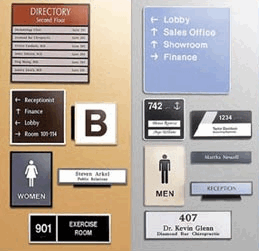The Effect of ADA Signs on Area Availability
The Effect of ADA Signs on Area Availability
Blog Article
Discovering the Key Functions of ADA Indicators for Improved Availability
In the realm of access, ADA indications serve as quiet yet powerful allies, making sure that areas are inclusive and navigable for people with impairments. By integrating Braille and responsive elements, these indications break barriers for the visually impaired, while high-contrast shade schemes and understandable fonts provide to diverse aesthetic demands.
Relevance of ADA Conformity
Ensuring compliance with the Americans with Disabilities Act (ADA) is vital for fostering inclusivity and equal gain access to in public rooms and offices. The ADA, enacted in 1990, mandates that all public centers, companies, and transport services fit people with handicaps, ensuring they take pleasure in the very same rights and possibilities as others. Compliance with ADA criteria not only satisfies legal responsibilities yet additionally enhances a company's reputation by showing its dedication to diversity and inclusivity.
One of the essential aspects of ADA compliance is the execution of obtainable signs. ADA signs are created to ensure that individuals with handicaps can easily browse with structures and rooms.
Moreover, adhering to ADA regulations can reduce the danger of legal consequences and prospective fines. Organizations that fall short to abide by ADA standards may deal with lawsuits or penalties, which can be both economically burdensome and destructive to their public image. Thus, ADA conformity is important to cultivating an equitable atmosphere for everybody.
Braille and Tactile Aspects
The consolidation of Braille and responsive components right into ADA signs symbolizes the concepts of availability and inclusivity. It is typically placed under the equivalent message on signage to make certain that people can access the info without visual support.
Tactile components extend past Braille and consist of increased characters and signs. These components are designed to be discernible by touch, allowing individuals to identify space numbers, bathrooms, exits, and various other crucial locations. The ADA sets certain guidelines pertaining to the size, spacing, and positioning of these tactile components to optimize readability and ensure consistency across different atmospheres.

High-Contrast Color Design
High-contrast color pattern play a pivotal function in boosting the visibility and readability of ADA signage for people with aesthetic problems. These systems are vital as they optimize the difference in light reflectance between text and background, making certain that signs are conveniently noticeable, even from a distance. The Americans with Disabilities Act (ADA) mandates making use of particular shade contrasts to suit those with limited vision, making it a crucial element of conformity.
The effectiveness of high-contrast shades hinges on their ability to attract attention in numerous lighting conditions, including dimly lit environments and locations with glow. Commonly, dark text on a light history or light message on a dark history is utilized to achieve optimal contrast. Black message on a yellow or white background provides a plain visual difference that helps in fast recognition and understanding.

Legible Fonts and Text Dimension
When considering the style of ADA signs, the selection of legible typefaces and ideal message size can not be overemphasized. The Americans with Disabilities Act (ADA) mandates that font styles must be sans-serif and not italic, oblique, script, highly decorative, or of uncommon form.
According to ADA standards, the minimum message elevation need to be 5/8 inch, and it should enhance proportionally with seeing range. Consistency in text size contributes to a natural aesthetic experience, aiding people in browsing settings efficiently.
Moreover, spacing between lines and letters is indispensable to readability. Adequate spacing protects check it out against personalities from pop over to these guys showing up crowded, improving readability. By sticking to these requirements, developers can substantially boost availability, making certain that signs serves its intended objective for all people, no matter their aesthetic abilities.
Effective Placement Methods
Strategic placement of ADA signs is important for optimizing accessibility and guaranteeing compliance with legal standards. ADA standards state that indicators need to be mounted at an elevation in between 48 to 60 inches from the ground to guarantee they are within the line of view for both standing and seated individuals.
In addition, indicators must be placed surrounding to the latch side of doors to enable easy identification before access. This placement aids people situate rooms and spaces without blockage. In situations where there is no door, signs should be positioned on the closest nearby wall surface. Consistency in indication positioning throughout a center enhances predictability, reducing confusion and boosting general customer experience.

Verdict
ADA indicators play an essential role in advertising accessibility by incorporating functions that deal with the requirements of people with handicaps. Including Braille and tactile aspects makes certain vital information comes to the visually impaired, while high-contrast color design and clear sans-serif typefaces improve visibility across different lighting conditions. Effective positioning techniques, such as ideal placing heights and tactical places, even more assist in navigation. These aspects jointly foster a comprehensive setting, underscoring the importance of ADA compliance in making sure equal gain access to for all.
In the realm of availability, ADA signs serve as quiet yet effective allies, ensuring that areas are Going Here accessible and comprehensive for people with handicaps. The ADA, enacted in 1990, mandates that all public centers, employers, and transport services suit people with handicaps, guaranteeing they enjoy the same legal rights and possibilities as others. ADA Signs. ADA indicators are developed to make certain that individuals with handicaps can easily navigate through buildings and areas. ADA guidelines specify that indicators need to be installed at an elevation between 48 to 60 inches from the ground to guarantee they are within the line of sight for both standing and seated individuals.ADA indicators play a vital function in promoting access by incorporating attributes that address the demands of individuals with disabilities
Report this page